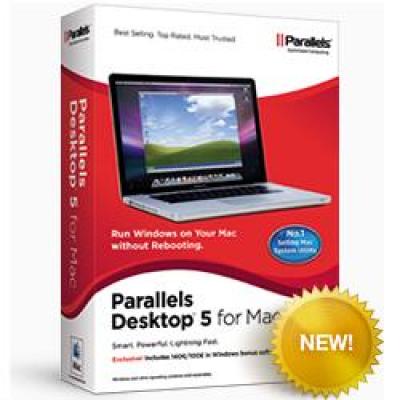The tight competition among products designed to push Windows onto the Mac got a little tighter with the 4 November release of Parallels Desktop 5.
Running neck-and-neck with rivals VMware Fusion 3 and Sun VirtualBox 3.0, Parallels Desktop can now make a Windows virtual machine appear as the only system in Full Screen mode or almost invisible and as just another Mac application in the new Crystal mode.
Parallels Desktop 5 also ships with a host of useful tools, including Acronis True Image and Acronis Disk Director Suite, to help manage VM creation. In addition, the product comes with a one-year subscription to Parallels Internet Security 2009 by Kaspersky Lab, a logical complement for a product designed to add Windows to the Mac.
PC users who are interested in making a move to the Mac platform should check out Parallels Desktop Switch to Mac Edition, which uses Parallels Desktop 5 as its underlying virtualisation engine.
I tested Parallels Desktop 5 on an Intel 1.66GHz Core Duo-based Mac Mini with 2GB of 667MHz DDR2 (double data rate 2) RAM running “Snow Leopard” and a Windows XP Service Pack 3 VM that was created under Parallels Desktop 4.
I upgraded this installation to Parallels Desktop 5 along with the VMs that had been created with Parallels Desktop 4. Windows applications such as Office, various Web browsers, and utilities including file transfer and audio playback worked with no noticeable difference in performance from when they were running on a native Windows system.

In Crystal mode, Parallels Desktop 5 places applications in the form of a Windows icon on the right side of the taskbar and a Parallels logo—used to access and control Windows applications—in the Apple menu bar. There are no other Windows artefacts on the screen in this mode, and the Windows OS and Windows-based applications appear as just another aspect of the Mac interface. When I started Windows applications in this mode, they appeared as applications in the Dock, distinguished with a Parallels symbol to note that the applications were running in Windows emulation mode.
During tests I also installed a Windows 7 Ultimate VM on an Intel 2.53 GHz Core 2-based MacBook Pro with 4GB of 1,067MHz DDR3 RAM running a clean installation of Snow Leopard and a new installation of Parallels Desktop 5. In Crystal mode, Windows applications ran with no noticeable difference in performance from when they were running in Windows natively. Parallels Desktop 5 also is able to emulate Windows Aero desktop effects, but sometimes in an awkward manner.
Expanded capacity
Parallels Desktop 5 provides new configuration maximums to support the increased computing power found in current laptop and desktop systems.
VMs can be assigned as many as eight CPUs, and, coming in line with rivals, Parallels Desktop 5 provides improved support for graphics-intensive CAD and gaming applications with Direct X 9Ex and OpenGL 2.1. It also now has a utility called Compressor that effectively resizes VMs to maximize performance while recognizing disk size constraints.
Parallels Desktop 5 costs $79.99 (£48.34), or $49.99 (£30.21) to upgrade.





